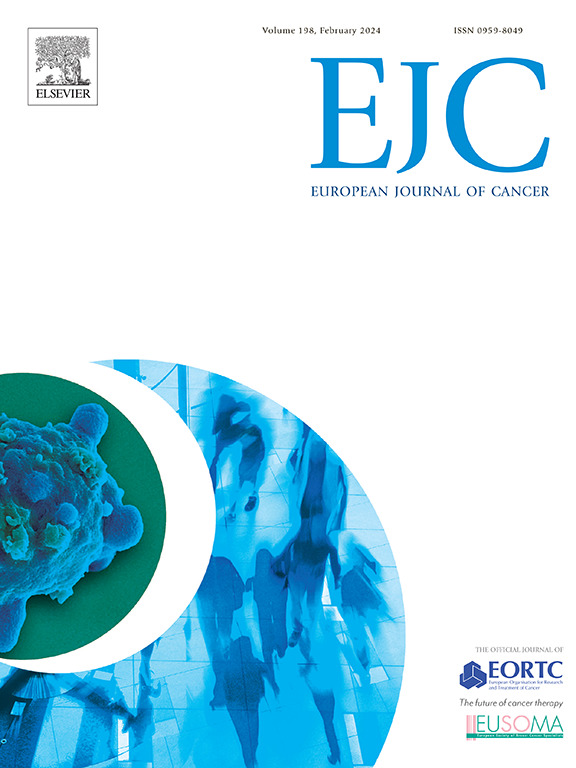Assessing the real-world effectiveness of 8 major metastatic breast cancer drugs using target trial emulation
IF 7.6
1区 医学
Q1 ONCOLOGY
引用次数: 0
Abstract
Background
Demonstration of trial emulation ability to benchmark randomised controlled trials (RCTs) from real-world data (RWD) is required to increase confidence in the use of routinely collected data for decision making in oncology.
Methods
To assess the frequency with which emulation findings align with RCTs regarding effect size on overall survival (OS) in metastatic breast cancer (MBC), 8 of 13 pre-selected pivotal RCTs in MBC were emulated using data from 32,598 patients enrolled in the French ESME-MBC cohort between January 1, 2008 and December 31, 2021. Adjustment methods and confounders were selected a priori for each emulation; stabilized weight was the reference method to mitigate confounding. Concordance in OS hazard ratios with associated 95 % confidence intervals between RCTs and emulations were assessed used predefined metrics based on statistical significance, estimates, and standardized differences.
Results
The effect sizes were consistent with RCT results in 7 out of the 8 emulations; 4 emulations achieved full statistical significance agreement; 5 emulations had a point estimate included in the RCT CI (estimate agreement); 6 emulations reported no significant differences between RCT and emulation (standardized difference agreement). Discrepancies related to residual confounders and significant shifts in prescription practices post-drug approval may arise in some cases.
Conclusion
Target trial emulation from RWD combined with appropriate adjustment can provide conclusions similar to RCTs in MBC. In oncology, this methodology offers opportunities for confirming the impact on long-term survival, for expanding indications in patients excluded from RCTs and for comparative effectiveness in single-arm trials using external control arms.
利用靶向试验模拟评估 8 种主要转移性乳腺癌药物的实际疗效。
背景:需要展示试验仿真能力,以真实世界数据(RWD)作为随机对照试验(RCT)的基准,从而增强人们对使用常规收集的数据进行肿瘤决策的信心:为了评估在转移性乳腺癌(MBC)总生存期(OS)效应大小方面仿真结果与RCT一致的频率,我们利用2008年1月1日至2021年12月31日期间入组法国ESME-MBC队列的32598名患者的数据,对13项预选的MBC关键RCT中的8项进行了仿真。每次模拟都事先选择了调整方法和混杂因素;稳定权重是减轻混杂因素的参考方法。使用基于统计显著性、估计值和标准化差异的预定指标,评估了RCT与模拟之间OS危险比及相关95%置信区间的一致性:在 8 个仿真结果中,有 7 个仿真结果的效应大小与 RCT 结果一致;有 4 个仿真结果的统计显著性完全一致;有 5 个仿真结果的点估计值包含在 RCT CI 中(估计值一致);有 6 个仿真结果显示 RCT 与仿真结果之间无显著差异(标准化差异一致)。在某些情况下,可能会出现与残余混杂因素和药物批准后处方做法的重大变化有关的差异:结论:RWD 的目标试验仿真结合适当的调整,可以在 MBC 中得出与 RCT 相似的结论。在肿瘤学领域,这种方法可用于确认对长期生存的影响、扩大被 RCT 排除在外的患者的适应症以及在使用外部对照臂的单臂试验中进行疗效比较。
本文章由计算机程序翻译,如有差异,请以英文原文为准。
求助全文
约1分钟内获得全文
求助全文
来源期刊

European Journal of Cancer
医学-肿瘤学
CiteScore
11.50
自引率
4.80%
发文量
953
审稿时长
23 days
期刊介绍:
The European Journal of Cancer (EJC) serves as a comprehensive platform integrating preclinical, digital, translational, and clinical research across the spectrum of cancer. From epidemiology, carcinogenesis, and biology to groundbreaking innovations in cancer treatment and patient care, the journal covers a wide array of topics. We publish original research, reviews, previews, editorial comments, and correspondence, fostering dialogue and advancement in the fight against cancer. Join us in our mission to drive progress and improve outcomes in cancer research and patient care.
 求助内容:
求助内容: 应助结果提醒方式:
应助结果提醒方式:


